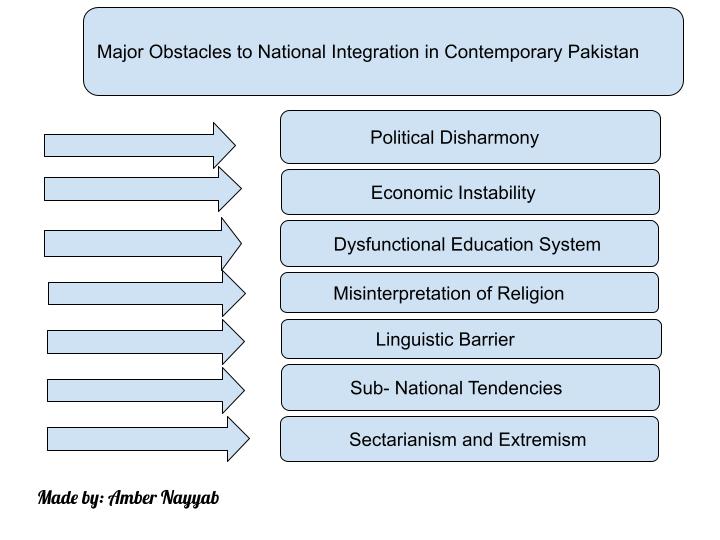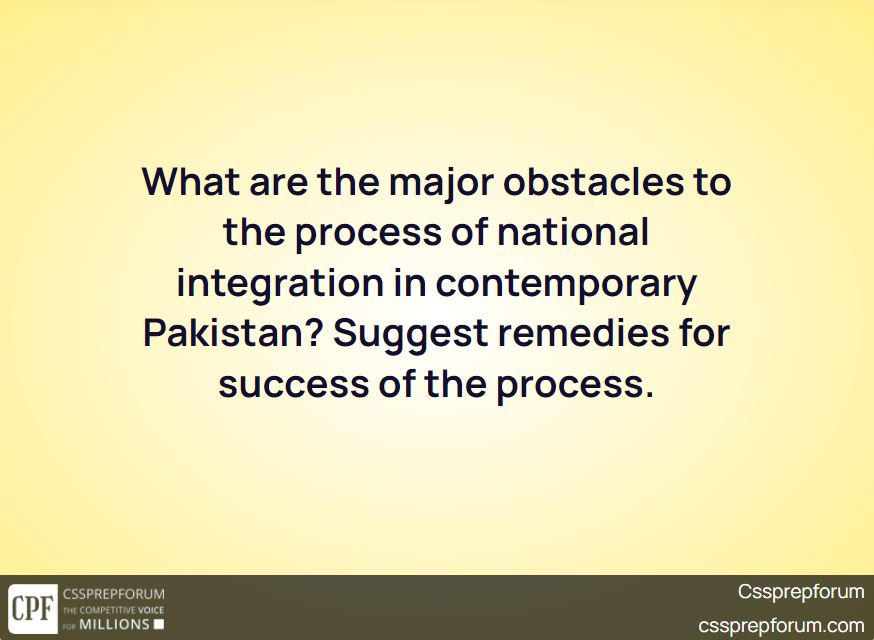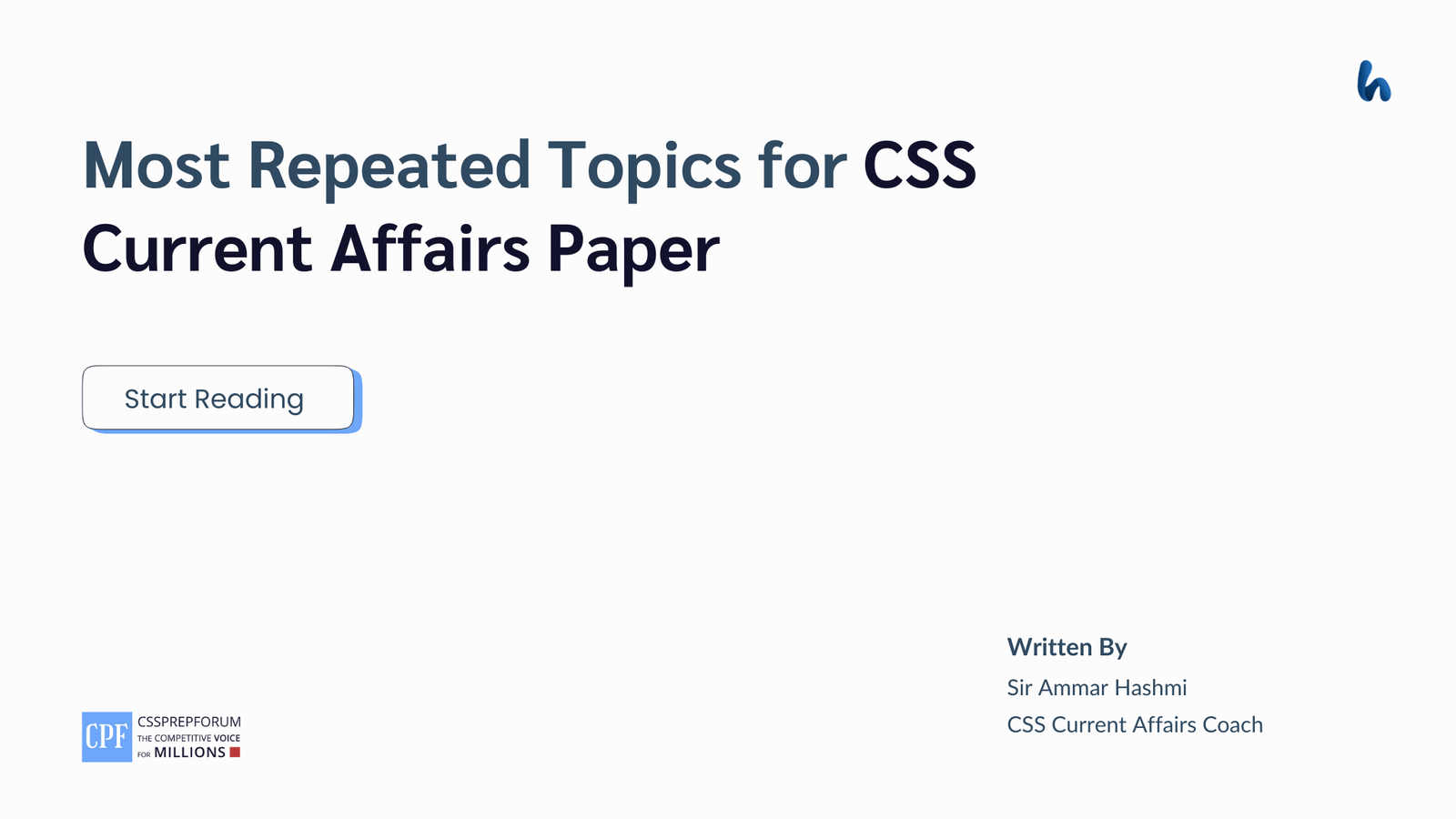CSS Solved Political Science Past Papers | What are the major obstacles to the process of national integration in contemporary Pakistan? Suggest remedies for success of the process.
The following question of Political Science is attempted on the same pattern, taught by Sir to his students, scoring the highest marks in compulsory subjects for years. This solved past paper question is uploaded to help aspirants understand how to crack a topic or question, how to write relevantly, what coherence is, and how to include and connect ideas, opinions, and suggestions to score the maximum.

Question Breakdown
This question consisted of four parts. Initially, you must provide a clear introduction and a precise definition of national integration. The main challenges to national integration in modern Pakistan must be discussed in the second section. In the third part, you offer a tenable solution to the problems associated with national integration. Then, in the end, write a critical analysis followed by a conclusion.
Outline
1- Introduction
2- Definition of National integration
3- Major obstacles in the process of National Integration in contemporary Pakistan
- ✓ Political Disharmony
- ✓ Economic Instability
- ✓ Dysfunctional education system
- ✓ Misinterpretation of Religion
- ✓ Linguistic barrier
- ✓ Sub- national tendencies
- ✓ Sectarianism and Extremism
4- Remedial measures to turm the table round
- ✓ Culture
- ✓ Strengthen social values
- ✓ Inter-provincial harmony
- ✓ Adoption of bottom-top approach
- ✓ Culture of tolerance
- ✓ Merit rather favouritism
- ✓ Empowered local governance
- ✓ Vibrant role of media
5- Best mode for National integration’s promotion
6- Critical Analysis
7- Conclusion

Answer to the Question
Introduction
National integration is the pursuit of harmony within the state. Irrespective of religion, race, creed, ethnic background, and language, national integration binds every segment of society for the unified cause of serving and developing a nation-state; therefore, it has great relevance and a direct bearing on national security. Pakistan is a multiethnic, multicultural, multilingual, and multi-religious society where people of all ethnicities, cultures, languages, and religious groups belonging to different provinces live together. Muslims of various sects constitute 97 percent of the population, with the remaining three percent belonging to other religions such as Christians, Hindus, Sikhs, and others. Despite this fact, contemporary Pakistan is facing challenges in national integration because of various factors such as political and economic instability, ethno-linguistic barriers, and a weak national identity. But still, there is a silver lining to this cloud. The process of national integration will be strengthened on the precondition that governance at the national level should be able to provide a strong sense of national identity and national pride through equal development and ensuring equal rights for all communities, regions and federating units.
“We are now all Pakistanis — not Balochis, Pathans, Sindhis, Bengalis, Punjabis and so on — and as Pakistanis we must feel, behave and act, and we should be proud to be known as Pakistanis and nothing else’.
Quaid-i-Azam Mohammad Ali Jinnah said in a reply to Civic Address presented by Quetta Municipality on June 15, 1948.
Definition of National integration
National integration describes a process that unites people from different sociocultural and racial backgrounds into a shared national identity to foster unity, harmony, and national consciousness. Additionally, it is a procedure that grants “identical prospects and equal rights” to various social groups.
“Integration as system cohesion, adaptation to structures, a bridging of elite-mass gap, the establishment of common norms and commitment to pattern of political behavior.”
–Fred M. Hayward
National integration develops as a result of a process of social and economic justice as well as democratic political pluralism; it cannot be artificially created. Although there are cultural, linguistic, and religious differences in many nations worldwide, wise and prudent leadership creates a sense of community and opens doors to advancement and development.
“National integration as a “socio-psychological and educational process through which feelings of unity, solidarity and cohesion develops in the hearts of the people, fostering a sense of common citizenship, and loyalty to the nation.”
-H. A Ghani
Major obstacles in the process of National Integration in Pakistan
Although national integration is pertinent in Pakistan, it is not achieved because of various challenges. Below are the various obstacles in the way of national integration:

- ✓ Political Disharomany
It is the responsibility of those in positions of authority and other interested parties in Pakistan residing in their comfort zones to look at and analyze how national integration processes have been launched and successfully completed in other nations with diverse cultures, languages, and religions. One cannot expect a nation to remain united and integrated as a whole without political will, tenacity, and leadership that is honest, clear, and visionary.
- ✓ Economic Instability
National integration is also severely hampered by economic instability. Because of the disparities in economic development and opportunities for employment, there is dissatisfaction among some provinces and their people that the majority province of Punjab is usurping their rights, especially the Sind and Balochistan provinces have such grievances. The MQM and PTM are two examples of nationalist movements fighting for their rights. Additionally, some Baloch dissidents who have been duped and supported by India and other powers ask for the independence of Balochistan, citing governments’ failure to ignore the development of their areas. Due to weak and equal economic growth across all provinces as well as corrupt and ineffective governments that failed to promote economic development and equal employment opportunities, the issues surrounding national integration are complicated.
- ✓ Dysfunctional education system
The dysfunctional educational system in Pakistan, which is unable to give children equal opportunities to pursue basic, high-quality education, is a major contributor to the failure of national integration in the creation of Pakistani men and women.There are three tier educational systems in Pakistan: public, private, and madrassah. Private schools are for children from affluent families, while public schools are for children from middle-class families. However, the mediocre and the carpet class favor Islamic education. As children from various schools learn different things so a gap will emerge in them, and this educational disparity has grown to be a significant hurdle in national integration. The youth of Pakistan, who make up about 50% of the population, cannot be expected to seek attachment to the land, values, culture, history, and other characteristics of the country in the absence of a uniform educational system, particularly in terms of curriculam and modes of education.
As stated in articles 25 and 25(A) of the Pakistani constitution,
The state should be responsible for providing free, mandatory, and high-quality education to all citizens of Pakistan through high school, regardless of their class, language, sect, religion, or place of origin.
- ✓ Misinterpretation of Religion
Religion presents a significant challenge to national integration in contemporary Pakistan. Despite Pakistan was established as a state like Israel on religious grounds, the situation is confusing and difficult right now. While Jews from all over the world arrived at their new home with a variety of cultures and eventually made up the majority in the region formerly known as Palestine, in the case of Pakistan, those who had migrated from India with Urdu as their common language were a minority because the native population already had their distinct languages and cultures. Therefore, despite the fact that the majority of Pakistanis are Muslims, there are still some who are migrants and others who are natives, and they all adhere to their own religious practices. As a result of their slightly different religious practices, integration is challenging and hampering national integration.
- ✓ Linguistic barrier
Language is also a significant barrier to promoting national integration. Language is a crucial tool in multilingual societies and civilizations, as it can either unite the nation by fostering national consciousness and unity or tear the fabrics of society apart by instilling feelings of marginalization and alienation. Despite not being the majority’s mother tongue and only being regarded as a lingua franca, Urdu has designated Pakistan’s national language after the country was founded. As a result, when Urdu was essentially imposed on then-East Pakistan, national language disputes first surfaced during Pakistan’s formative years. Even though Bengali and Urdu were recognized as national languages in 1956, the damage had already been done, and Bengali nationalism emerged as a powerful force that ultimately contributed to the breakup of Pakistan in December 1971. Again, when Sindhi was proclaimed the official language of the province by the Sindh Assembly in July 1972, language riots broke out, demonstrating that the Pakistan of the post-1971 era had not learned any lessons from the trauma of separation. It is the official language of Balochistan, KPK, and Punjab, even though it is not widely spoken in Pakistan’s provinces. Language, therefore, poses a serious obstacle to Pakistan’s integration.
✓ Sub- national tendencies
Subnational tendencies also hamper national integration in Pakistan. Subnationalism in Pakistan first emerged as a result of the Pakistani federation’s inability to amicably resolve disputes over language or provincial status from the beginning. Sub-nationalism and a militant culture have emerged in Pakistan due to long-term neglect, racial and political interests, tribal culture, and weak governance, which anti-state elements have abused. These factors threaten the country’s social structure and national integration.
- ✓ Sectarianism and Extremisim
The most complex threat to Pakistan’s national integration is sectarianism and extremism. Myopic and defunct religious ulemas have altered the islmaic interpretations. Numerous extremist and sectarian groups emerged in Pakistan as a result of misinterpretation. For example, various parties including the TTP (Tehreek e Taliban Pakistan) and the TLP (Tehreek e Labaik Pakistan). Similarly, several names in Pakistan catalyze extremism and sectarianism. It caused Pakistan to suffer severe losses in terms of people’s lives, property, and reputation abroad and as a result impedes national integration.
Remedial Measures to turn the table round
Integration on a national level is unquestionably important. However, it is challenging to achieve due to several integration-related challenges that have been discussed. However, against this cloudy horizon, steering the process of national integration urges the federal government to focus on the following steps:

- ✓ Culture
Culture plays an important role in promoting national integration. As in every culture, people’s way of life is determined by their beliefs and customs. Thus, in multicultural societies, national integration is viewed as a tool to minimize cultural differences even in complex societies and forge uniformity across the nation.
- ✓ Strengthen social values
Many countries have trouble bringing their different groups of people together, but in a few cases, their leaders have been able to do so by promoting social justice, tolerance, the rule of law, good governance, and democratic pluralism. All of the provinces need a good National Social Action Plan (NSAP) to meet their social, economic, and political needs. It will reduce the imbalance between regions and provinces and give the federating units a stronger sense of ownership, which will help the process of national integration.
- ✓ Inter-provincial harmony
To gear up national integration, interprovincial internship programs with alluring benefits for qualified professionals like physicians, engineers, and managers of businesses should be promoted. At the national level, trade, labor, legal, and medical unions should be revitalized.
- ✓ Adoption of bottom-top approach
Pakistan’s quest for national integration would remain elusive without a bottom-up strategy. Thus, developing a sense of national identity at the grassroots level is necessary.
- ✓ Culture of tolerance
What is known as “Pakistaniat” will be promoted to a great extent by taking care of the nation’s resources and pursuing a tolerant attitude toward those who are different from one another in terms of race and language. The federal government should start holding regular seminars in the capitals of each province to teach people the value of unity in diversity and promote ethnic and social harmony. It will surely promote national integration.
- ✓ Merit rather than favouritism
Promoting a culture of merit instead of favouritism and nepotism is the best way to reach the goal of national integration.
- ✓ Empowered local governance
An empowered local body system is indispensable for Pakistan to keep people satisfied, narrowing down the spread of mistrust and reducing separatist tendencies. Power transfer from the provinces to local entities is a practical step toward ensuring the political system’s continued development and the inclusion of the underprivileged.
- ✓ Vibrant role of media
The media is crucial for fostering national unity and cultural fusion. A strong national story needs to be told to counter the extremist, sectarian, and provincial stories that are already out there.
The best mode for National integration promotion
The railways are the only means of communication to foster national integration, as people from various provinces and regions travel together and exchange language, culture, and ways of life. In a nutshell, an insecure state will favor a certain class or ethnic group in order to maintain its hold on power, but it won’t be aware of the harm done to the nation by pursuing such a policy.
Critical Analysis
The creation of “a national identity out of the diverse regional, linguistic, and cultural identities” remains a challenge for Pakistan’s political leadership. The obstacles to national integrity are not just internal to Pakistan; they also stem from the unfavorable conditions and environments that outside forces create to make things worse. It keeps economic inequalities, ethno-religious extremism, political instability, and sub-national tendencies at home alive. The phenomenon of national integration has been complicated further by Pakistan’s victimization by externally hostile states. Thus, national integration is conditional and only adopted at the need of the hour.
“National integration in Pakistan only emerges in times of natural disaster, national dilemma or an external threat. Once the threat is dealt with, the internal contradictions re-appear.”
-Dawn
Conclusion
To sum up, national integration is a process of bringing together culturally and socially distinct groups within the unified geographical boundaries of the country in order to create a sense of oneness among them that is integral to national unity. People think that the mix of languages, cultures, and ethnicities is what makes a country a nation and that people-friendly policies encourage everyone to play a positive role in building the country. Contrary to this, any sense of marginalization, ethno-linguistic and sectarian schisms, extremism, caste-creed cleavages, and socioeconomic deprivation are the impediments to the growth of nationhood. In fact, one of the main goals of national integration is now to figure out how feelings of oneness and human development are linked. These two elements are interlinked. There will be no feelings of togetherness without human resource development and no human resource development without feelings of togetherness. In Pakistan, successive governments could not get the desired progress in human capital formation to remove socio-economic injustices in Balochistan, interior Sindh, South Punjab, and the tribal belt. Political and social problems in the country are made worse by provincialism, differences in ethnic and cultural backgrounds, bad government, and unequal access to education and health care. As a result, socio-cultural and political fault lines remain the dominant features of Pakistani society, which are major impediments to national integration.
CSS Solved Past Papers’ Essays
Looking for the last ten years of CSS and PMS Solved Essays and want to know how Sir Kazim’s students write and score the highest marks in the essays’ papers? Then, click on the CSS Solved Essays to start reading them.
CSS Solved Essays

CSS Solved General Science & Ability Past Papers
Want to read the last ten years’ General Science & Ability Solved Past Papers to learn how to attempt them and to score high? Let’s click on the link below to read them all freely. All past papers have been solved by Miss Iqra Ali & Dr Nishat Baloch, Pakistan’s top CSS GSA coach having the highest score of their students.
General Science & Ability Solved Past Papers
CSS Solved Pakistan Affairs Past Papers
Want to read CSS Pakistan Affairs Solved Past Papers and learn how to attempt them to score high? Let’s click on the link below to read them all freely. All past papers’ questions have been attempted by Sir Kazim’s students, who scored the highest in the subject.
CSS Solved Pakistan Affairs
CSS Solved International Relations’ Past Papers
Have you opted for International Relations in the CSS examination and want to score above 150? Then, click on the CSS Solved International Relations’ Past Papers by Miss Abeera Fatima, the top IR scorer and the best IR coach in Pakistan.
CSS Solved International Relations Past Papers
Articles Might Interest You!
The following are some of the most important articles for CSS and PMS aspirants. Click on any to start reading.












